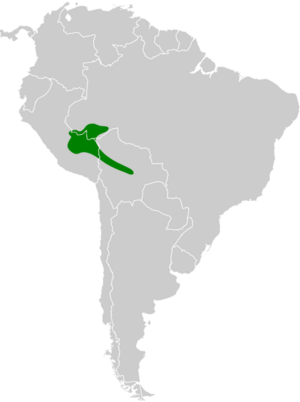Black-capped tinamou facts for kids
Quick facts for kids Black-capped tinamou |
|
|---|---|
| Conservation status | |
| Scientific classification | |
| Genus: |
Crypturellus
|
| Species: |
atrocapillus
|
| Subspecies | |
|
C. a. atrocapillus |
|
 |
|
The black-capped tinamou (Crypturellus atrocapillus) is a special bird that lives in warm, wet forests. It's a type of tinamou, which are birds found in Central and South America. You can often find them in the lowlands of subtropical and tropical regions.
Contents
What is a Tinamou?
Tinamou birds belong to a family called Tinamidae. They are also part of a bigger group called ratites. Other ratites include ostriches and emus. Unlike most other ratites, tinamous can fly. However, they are not very strong flyers. Scientists believe tinamous are the closest living relatives to ancient flying birds.
Different Kinds of Black-capped Tinamou
The black-capped tinamou has two main types, called subspecies:
- C. a. atrocapillus: This type lives in the lowlands of southeastern Peru.
- C. a. garleppi: This type is found in the lowlands of northern Bolivia.
What Does Its Name Mean?
The scientific name for this bird is Crypturellus atrocapillus. The first part, Crypturellus, comes from three Latin or Greek words.
- kruptos means "covered" or "hidden."
- oura means "tail."
- ellus means "small."
So, Crypturellus means "small hidden tail." The second part, atrocapillus, means "black-capped," which describes the bird's head.
What Does the Black-capped Tinamou Look Like?
The black-capped tinamou is about 28 to 30 centimeters (11 to 12 inches) long. Its upper body is brown with blackish spots and stripes. The throat and neck are reddish-brown. Its chest is dark gray, and the rest of its underside is a warm cinnamon or buff color. As its name suggests, it has a blackish cap on its head. Its legs can be pale red or bright red. Female tinamous usually have more stripes on their upper bodies than males.
How Do They Behave?
Like other tinamous, the black-capped tinamou mostly eats fruit. They find fruit on the ground or on low bushes. They also snack on small invertebrates, flower buds, soft leaves, seeds, and roots.
Parenting in Tinamous
Male black-capped tinamous are very involved parents. A male might incubate eggs from up to four different females! He then raises the chicks until they are ready to live on their own. This usually takes about two to three weeks. Their nests are built on the ground. They often hide them in thick bushes or between large tree roots.
Where Do They Live?
The black-capped tinamou lives in warm, wet forest lowlands. They can be found at altitudes up to 900 meters (about 2,950 feet). These birds are originally from southeastern Peru and northern Bolivia. Recently, they have also been seen in Brazil.
Are They in Danger?
The black-capped tinamou lives in a large area, estimated to be about 120,000 square kilometers (46,000 square miles). Because of this, the IUCN (International Union for Conservation of Nature) has listed them as a species of "least concern." This means they are not currently at high risk of disappearing.


